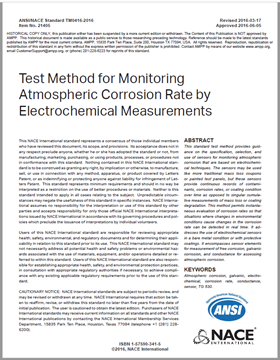Search
NACE Standards
View as
Sort by
Display
per page
ANSI/NACE TM0416-2016, “Test Method for Monitoring Atmospheric Corrosion Rate by Electrochemical Measurements”
Product Number:
21405-SG
Publication Date:
2016
$179.00
ANSI/NACE TM0416-2023/ISO 22858:2020, Corrosion of metals and alloys — Electrochemical measurements — Test method for monitoring atmospheric corrosion
Product Number:
ANSI-NACE TM0416-2023-ISO 22858-2020
$149.00
ANSI/NACE/ISO MR0103-HD2010, Materials Resistant to Sulfide Stress Cracking in Corrosive Petroleum Refining Environments
Product Number:
21305-HD2010
ISBN:
1-57590-168-4
Publication Date:
2010
$179.00
Application Process for Optimum Paint and Coating Systems’ Performance for Navy Ships
Product Number:
SP21416-2020
Publication Date:
2020
$109.00
ICRI Technical Guideline 03741/NACE Publication 02203/SSPC-TR 5-2003, Design, Installation, and Maintenance of Protective Polymer Flooring Systems for Concrete
Product Number:
24220-SG
Publication Date:
2003
$179.00
Metallic and Ceramic Thermal Spray Coatings For Oil and Gas Production Equipment
Product Number:
1G191-1991
Publication Date:
1991
$179.00
MR0103-2012-Spanish, “Materiales Resistentes a Agrietamiento de Sulfuro por Corrosión bajo Tensión en Entornos de Refinación de Petróleo Corrosivos”
Product Number:
21183-SG
ISBN:
1-57590-168-4
Publication Date:
2012
$179.00
MR0174-1988, Recommendations for Selecting Inhibitors for Use as Sucker Rod Thread Lubricants
Product Number:
53017-HD1988
Publication Date:
1988
$179.00
MR0174-2007-SG, Selecting Inhibitors for Use as Sucker-Rod Thread Lubricants
Product Number:
21300-SG
ISBN:
1-57590-120-X
Publication Date:
2007
$109.00
MR0174-HD1995-SG Selecting Inhibitors for Use as Sucker-Rod Thread Lubricants-HD1995
Product Number:
21300-HD1995
Publication Date:
1995
$179.00
MR-01-74-HD1995-SG, Recommendations for Selecting Inhibitors for Use as Sucker Rod Thread Lubricants
Product Number:
MR-01-HD1974
Publication Date:
1995
$179.00













